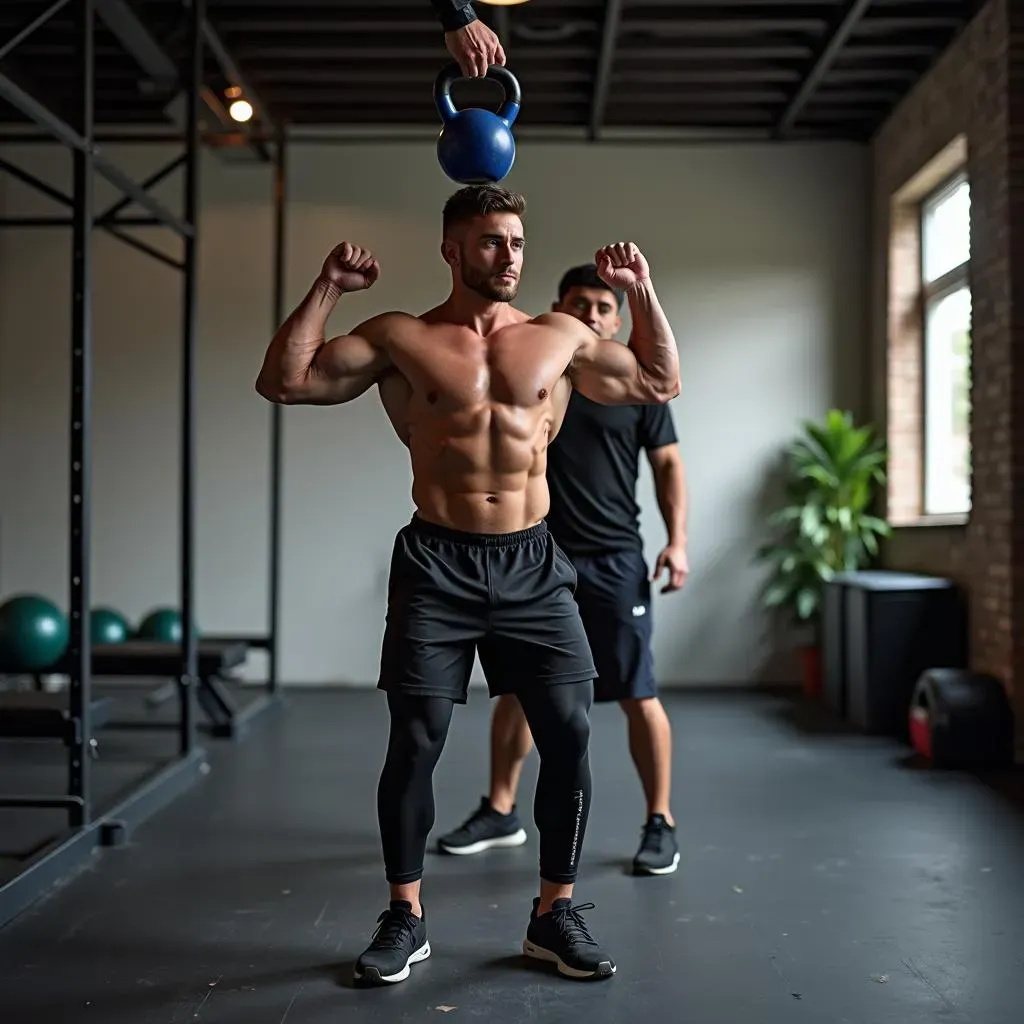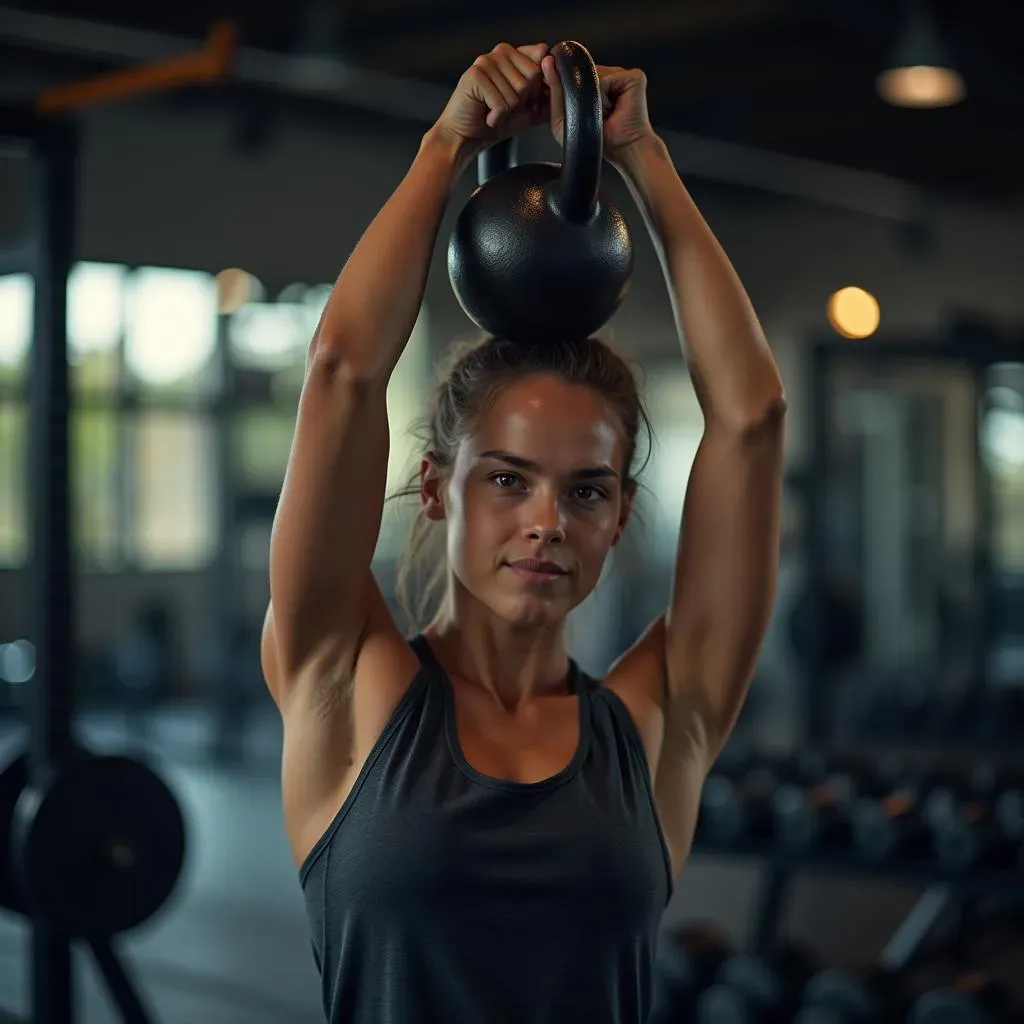Table of Contents
Looking to build a powerful back and sculpted shoulders? A back and shoulder kettlebell workout is your answer. Kettlebells offer a unique way to target these muscle groups, improving strength, stability, and overall fitness. This article isn't just a list of exercises; it's a comprehensive guide to designing a safe and effective routine.
Kettlebell Exercises for a Stronger Back and Shoulders

Kettlebell Exercises for a Stronger Back and Shoulders
Unlocking Back Strength with Kettlebells
so you're looking to beef up your back and shoulders with kettlebells? Awesome choice! Kettlebells are fantastic because they force your body to stabilize and control the weight, which translates to serious strength gains and improved muscle definition. We're not just talking about looking good; a strong back and shoulders are crucial for posture, injury prevention, and just feeling like a badass.
Think about it: how many times a day do you lift, push, or pull something? A solid foundation in your back and shoulders makes those everyday tasks easier and safer. Plus, the kettlebell's offset center of gravity kicks your core into overdrive, giving you a bonus ab workout without even trying. Ready to dive into some killer exercises?
Shoulder Sculpting with Kettlebell Movements
When it comes to shoulders, kettlebells offer a unique challenge compared to dumbbells or barbells. The dynamic nature of kettlebell exercises engages your shoulder muscles in a way that promotes stability and mobility, not just raw strength. This is key for preventing injuries and improving your overall shoulder health. We're talking about exercises that work your deltoids from every angle, giving you that well-rounded, sculpted look.
And let's be real, who doesn't want a set of strong, defined shoulders? Whether you're rocking a tank top or just want to feel confident in your own skin, kettlebell shoulder exercises can help you achieve your goals. From presses to raises to rotational movements, there's a kettlebell exercise to target every part of your shoulder complex. Let's get started!
Exercise | Target Muscles | Benefits |
|---|---|---|
Kettlebell Rows | Lats, Rhomboids, Traps | Builds back thickness and pulling strength |
Kettlebell Halos | Shoulder Girdle, Upper Back | Improves shoulder mobility and warm-up |
Kettlebell Overhead Press | Deltoids, Traps, Core | Develops shoulder strength and stability |
Designing Your Back and Shoulder Kettlebell Workout Routine

Designing Your Back and Shoulder Kettlebell Workout Routine
Assessing Your Current Fitness Level
Alright, so you're ready to design your own back and shoulder kettlebell workout routine? First things first, let's be real with ourselves. What's your current fitness level? Are you a seasoned athlete, or are you just starting your fitness journey? This isn't about judging; it's about setting yourself up for success. If you jump into a super intense routine right away, you're just asking for injury and burnout. Start slow, focus on form, and gradually increase the intensity as you get stronger. Think of it like learning to play an instrument; you wouldn't start with a concerto, right?
A good way to gauge your fitness level is to try a few basic kettlebell exercises and see how you feel. Can you comfortably perform 10-12 reps of a kettlebell row with good form? How about a few overhead presses? If you're struggling with the basics, it's a sign that you need to focus on building a solid foundation before moving on to more advanced movements. Don't worry, everyone starts somewhere! The key is to be patient, consistent, and listen to your body.
Choosing the Right Exercises for Your Goals
now that you've assessed your fitness level, it's time to choose the right exercises for your goals. What are you hoping to achieve with your back and shoulder kettlebell workout routine? Are you looking to build strength, increase muscle size, improve endurance, or just feel better overall? Your goals will dictate the types of exercises you should include in your routine. For example, if you're looking to build strength, you'll want to focus on heavier weights and lower reps. If you're looking to improve endurance, you'll want to use lighter weights and higher reps.
It's also important to choose exercises that target all the different muscles in your back and shoulders. Don't just focus on the muscles you can see in the mirror! Make sure you're working your lats, rhomboids, traps, deltoids, and rotator cuff muscles. A well-rounded routine will help you build a balanced physique and prevent injuries. Here's a quick guide to some effective kettlebell exercises for different muscle groups:
Muscle Group | Kettlebell Exercises |
|---|---|
Lats | Kettlebell Rows, Swings |
Rhomboids & Traps | Kettlebell Rows, Face Pulls |
Deltoids | Overhead Press, Lateral Raises |
Rotator Cuff | External Rotations, Internal Rotations |
Structuring Your Weekly Workout Schedule
Alright, so you've got your exercises picked out, now how do you fit them into a weekly schedule? Consistency is key when it comes to seeing results, so aim for at least 2-3 back and shoulder kettlebell workout routine sessions per week. Remember to allow for adequate rest and recovery between workouts. Overtraining can lead to injuries and burnout, so don't push yourself too hard, especially when you're just starting out.
A good starting point is to alternate between upper body and lower body workouts, giving your muscles time to recover. For example, you could do a back and shoulder workout on Monday, a leg workout on Wednesday, and another back and shoulder workout on Friday. You can also incorporate rest days or active recovery days into your schedule. Active recovery involves light activities like walking, stretching, or yoga, which can help improve blood flow and reduce muscle soreness. Listen to your body and adjust your schedule as needed. The most important thing is to find a routine that you can stick with long-term.
Kettlebell Workout for Back and Shoulder: Technique and Safety

Kettlebell Workout for Back and Shoulder: Technique and Safety
Mastering the Kettlebell Swing for Back Health
Alright, let's talk technique, because when it comes to a kettlebell workout for back and shoulder, safety is non-negotiable. And there's no better place to start than with the kettlebell swing. This exercise is a powerhouse for your posterior chain, but it's also one of the most commonly butchered. The key is to hinge at the hips, not squat. Think of it like you're hiking a football between your legs, keeping your back straight and your core engaged. The power comes from your glutes and hamstrings, not your arms. Your arms are just along for the ride, guiding the kettlebell.
Imagine a straight line from the top of your head to your tailbone throughout the movement. Avoid rounding your back or hyperextending at the top. The kettlebell should float up to chest height, not be pulled up with your arms. If you're feeling it in your lower back, chances are you're not hinging properly or you're using too much weight. Start with a lighter kettlebell and focus on perfecting your form. Trust me, a properly executed swing is worth its weight in gold when it comes to back health.
Protecting Your Shoulders During Overhead Pressing
Overhead pressing with kettlebells is a fantastic way to build shoulder strength and stability, but it's also where a lot of people run into trouble. One of the biggest mistakes I see is people rushing the movement and not controlling the kettlebell on the way down. The eccentric (lowering) phase is just as important as the concentric (lifting) phase, so make sure you're lowering the kettlebell slowly and deliberately, engaging your lats to control the descent. This helps protect your rotator cuff and prevent shoulder impingement.
Another key is to maintain proper alignment throughout the movement. Keep your wrist straight, your elbow slightly in front of your body, and your shoulder packed (imagine squeezing your shoulder blade down and back). Avoid shrugging your shoulders up towards your ears. Think about pressing the kettlebell up and slightly back, finishing with your bicep next to your ear. If you're feeling any pain in your shoulder, stop immediately and assess your form. It's always better to err on the side of caution when it comes to your shoulder health.
Avoiding Common Kettlebell Training Mistakes
Beyond the swing and the press, there are a few other common mistakes people make during a kettlebell workout for back and shoulder. One is using momentum to power through the exercises. Kettlebells are designed to be dynamic, but that doesn't mean you should be swinging them around like a ragdoll. Focus on controlled movements and engaging your muscles throughout the entire range of motion. Cheating may allow you to lift heavier weights, but it also increases your risk of injury and reduces the effectiveness of the exercise.
Another mistake is neglecting proper warm-up and cool-down routines. A dynamic warm-up that includes movements like arm circles, torso twists, and leg swings can help prepare your muscles and joints for the workout ahead. A cool-down that includes static stretching can help improve flexibility and reduce muscle soreness. Finally, don't forget to listen to your body. If you're feeling pain, fatigue, or any other warning signs, take a break and adjust your routine as needed. Your body is your best guide, so learn to trust its signals.
Mistake | Consequence | Solution |
|---|---|---|
Using Momentum | Increased risk of injury, reduced effectiveness | Focus on controlled movements, engage muscles |
Neglecting Warm-up/Cool-down | Increased risk of injury, muscle soreness | Include dynamic warm-up and static stretching |
Ignoring Body Signals | Overtraining, injury | Listen to your body, adjust routine as needed |
Progressing Your Back and Shoulder Kettlebell Training

Progressing Your Back and Shoulder Kettlebell Training
Increasing Weight and Volume Over Time
So, you've been crushing your back and shoulder kettlebell training for a few weeks now, and you're feeling stronger. Awesome! But if you want to keep making progress, you can't just keep doing the same thing over and over again. Your body adapts quickly, so you need to continually challenge it with new stimuli. This is where progressive overload comes in. The most straightforward way to overload is by increasing the weight you're lifting. If you've been using a 16kg kettlebell for rows, try bumping it up to a 20kg kettlebell. Even a small increase can make a big difference.
Another way to overload is by increasing the volume of your workouts. This means doing more sets, more reps, or both. For example, if you've been doing 3 sets of 10 reps of overhead presses, try doing 4 sets of 12 reps. You can also add extra exercises to your routine to target your back and shoulders from different angles. Just remember to increase the weight or volume gradually to avoid injury. Don't try to add 10kg to your press overnight!
Exploring Advanced Kettlebell Exercises
Once you've mastered the basics, it's time to explore some more advanced kettlebell exercises to spice up your back and shoulder kettlebell training. These exercises will challenge your strength, stability, and coordination in new ways, helping you break through plateaus and continue making progress. One of my favorites is the Turkish Get-Up. This full-body exercise is a fantastic way to build shoulder stability and core strength, while also improving your overall mobility. It's a complex movement, so start with a light weight and focus on mastering the technique before going heavy.
Another great advanced exercise is the bottoms-up press. This involves pressing the kettlebell overhead with the handle facing up. It requires incredible shoulder stability and control, and it's a real test of your pressing strength. You can also try variations like the renegade row, which combines a plank with a kettlebell row, challenging your core and back muscles simultaneously. Just remember to progress gradually and listen to your body. These exercises are tough, so don't be afraid to start with a lighter weight or modify the movement as needed.
Progression Method | Description | Example |
|---|---|---|
Increase Weight | Use a heavier kettlebell | Row with 20kg instead of 16kg |
Increase Volume | Do more sets or reps | 4 sets of 12 reps instead of 3 sets of 10 |
Advanced Exercises | Incorporate more complex movements | Turkish Get-Up, Bottoms-Up Press |
Conclusion: Kettlebells for a Stronger, More Resilient You
Incorporating a back and shoulder kettlebell workout into your fitness regimen can be a game-changer. By focusing on proper technique, progressive overload, and listening to your body, you can unlock significant strength gains, improve shoulder mobility, and build a resilient physique. Remember, consistency is key. So, grab a kettlebell, follow the guidelines outlined in this article, and start building the back and shoulders you've always wanted. It's not just about aesthetics; it's about building a stronger, healthier, and more capable you.